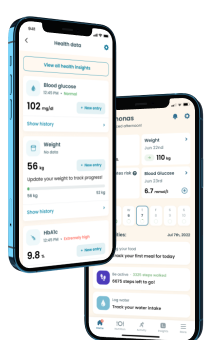What Makes a Good Breakfast for People With Diabetes?

You’ve probably heard the widely held belief that you ought to eat breakfast like a king, lunch like a prince, and dinner like a pauper. This is true! More so for people with diabetes who require a regular (and not too heavy) supply of calories throughout the day. Although there are different popular opinions about whether breakfast is good or bad, scientific research shows that breakfast is indeed essential and that a good breakfast will keep your body satisfied. In contrast, skipping breakfast leads to feeling hungry and tired, which in most cases leads to overeating at lunch or dinner.
Why Is It Important for People With Diabetes To Eat Breakfast?
Sure, breakfast is important, but there may be times when a person with diabetes skips breakfast. So is it OK for people with diabetes to skip breakfast? In short – No! Since diabetes is a condition in which blood sugar levels can become unmanageable, it’s crucial to avoid going too long without eating because this lowers blood sugar levels and could lead to overeating.
After that, you may ask: Well, what’s wrong with compensating for a skipped breakfast? The primary concern is that consuming too much can lead to a sudden spike in blood sugar levels (or hyperglycemia) that places the individual at risk of excessive hunger, thirst, a frequent need to urinate, increased heart rate, blurred vision, etc., which can, in turn, lead to more severe health problems, when left untreated – even stroke or a coma.
What Is The Best Breakfast for a Person With Diabetes To Eat?
Now that we’re clear that breakfast should ideally not be skipped, let’s explore the secret to the best breakfast for people with diabetes? The answer to this lies in the diet you and your physician/registered nutritionist have chosen. A number of diets work well for diabetes patients, those with or those prone to hypertension (high blood pressure) or heart-related conditions. So, the best breakfast foods for those with diabetes can be found within these diets:
DASH Diet:
This is a great diet that can be adopted by everyone! It’s balanced, healthy, and ideal for everyone in the family (regardless of whether they have diabetes or any other health condition). As the name states, the DASH diet or the Dietary Approaches to Stop Hypertension primarily deals with lowering or managing hypertension. Studies have shown that two-thirds of all people with diabetes also suffer from hypertension. Not only does this diet address hypertension, but is also highly beneficial for people with type 1 and type 2 diabetes.
So, this highly recommended diet includes eating a lot of fruits and vegetables: at least half your plate per meal. Although universally recommended for good health and their high vitamin, mineral, and fiber content, fruits and veggies are recommended in this diet because they contain potassium which helps control blood pressure. So, include one or more fruits, juice, and veggies in your breakfast.
Also, include nuts: almonds, walnuts, hazelnuts, pecans, and other nuts, which are high in healthy fats. These fats help lower ‘bad’ cholesterol (LDL) and help keep blood vessels healthy and unclogged (clogging may be caused by plaque deposited along vessel walls when the blood carries too much ‘bad’ cholesterol and sugar. The body can only use a limited number of nuts, so go easy! The increased number of nuts is not likely to make you healthier, owing to the normal body’s limited ability to absorb nutrients from nuts.
Calcium – found in dairy (go for the fat-free or low-fat kind), eggs, fish, yogurt, tofu, spinach, etc., is very important for blood vessel health, enabling the vessels to function normally and thus maintaining healthy blood pressure. Calcium and Vitamin D deficiency also affects insulin resistance in the body, which is the main cause of the development of diabetes. Including calcium-rich foods is a great way to manage diabetes and stay healthy. If you love your eggs every morning, remember that although it’s a great source of calcium and protein, try to stick to having only three eggs per week. When you cook eggs, keep butter or oils to a minimum – or eat them boiled!
Lower salt (since it contains sodium) try to keep sodium intake levels at 2.3g per day and unhealthy fats intake. When you cook at home, try using low sodium salt, and when you go out to eat, remember to look for the nutrients list for each menu item before ordering, or simply ask for low salt and low-fat dishes.
Staying active and lowering alcohol consumption. Since a sedentary lifestyle is a leading cause of diabetes, regular exercise or an active lifestyle can help manage diabetes and reduce the risk of diabetes developing at later stages. Alcohol consumption causes a higher risk of developing and can contribute to diabetes progression.



Here are a few DASH diet breakfast recipes to help you get started:
- Wild mushroom oatmeal with herbs. This dish is a savory and robust meal with eggs, wild mushrooms, scallions, lemon juice, pepper, rosemary, olive oil, and a dash of low sodium sea salt.
- Grilled banana split fruit salad accompanied by raspberries, Greek yogurt, pineapple chunks, strawberries, almonds, and a dash of semi-sweet dark chocolate. This delectable dish is packed with fiber, vitamins, and minerals to fuel your day.
- Scrambled eggs, spinach, mushrooms, and feta cheese. This recipe can be amped with fresh veggies like tomatoes, olives, bell peppers, or onions for a flavor-filled breakfast.
Keto Diet:
The keto diet is a simpler version of the Atkins or Very Low Carbohydrate Ketogenic Diet (VLCKD). The difference is that the Atkins diet requires constant monitoring and adjusting the diet to the needs of the body, with exact measures of fats, nutrients, and carbs being consumed on a short-, mid-, and long-term basis.
With the Keto diet, the process is not as measured and is simply dependent on limiting carbohydrate intake to a minimum and increasing fat intake to a point where a condition called ketosis is induced in the body. Under this condition, the body is forced to use fats to produce energy instead of carbs. Such a process reduces the body’s dependence on insulin.
The great thing about this diet is that a good-fat-heavy diet helps to keep the glycemic index and the lipid profile within a favorable range. Studies have shown that the keto diet effectively controls type 2 diabetes and obesity and sometimes reverses the diabetic condition.
So, what do you need to keep in mind with the keto diet? Keep carbs to a low of less than 20g per meal, increase proteins to at least 10g and add in good fats, but not too much.
Some appetizing options for keto-diet breakfast ideas are:
- Egg muffins with lean turkey bacon – Yes! Eggs are a great source of protein and can be eaten for breakfast as long as you don’t do it daily. How many eggs can a person with diabetes have in a day? Some studies say you can have two eggs a day, 3-6 days a week, while some recommend limiting egg consumption to one a day, 3-4 days a week. Whatever you choose, keep your physician or nutritionist-recommended diet to stay healthy.
- Salmon and cream cheese wrap. Fish is a fantastic source of proteins and healthy fats like Omega-3 fatty acids – these are super-good in maintaining heart health. Cream cheese is the healthier option for cheese and mayo cravings.
- Chocolate chia seed pudding with almond milk. This simple make-ahead recipe is packed with fiber, antioxidants, and nutrients with the creamy goodness of cocoa. It only contains 0.2g of sugar/carbs!
Mediterranean Diet
Eating heart-healthy foods has been proven to be very effective in managing diabetes. When blood sugar, weight, ‘bad’ cholesterol (LDL), and high blood pressure are maintained within a healthy range, diabetes is also controlled! The Mediterranean diet is enjoyable and can also be followed by the whole family. The diet includes as much fresh and seasonal produce as possible, whole grains such as barley, wheat, etc., heart-healthy oils such as olive oil and fish oils from fish, and limited quantities of wine. Foods are best cooked by baking, roasting, grilling, or steaming rather than frying. The Mediterranean diet calls for a wide range of natural and healthy taste enhancers such as lemon juice, garlic, and salt-free herbs and spices.
The bottom line is you get the right portions with low fat, sugar, and salt content with the Mediterranean diet. Here are a few Mediterranean breakfast ideas:
- Maple granola. Oats-based and full of flavor with maple syrup, pecans, your favorite mix of nuts, and a dash of cinnamon. This can be enjoyed as is or with a banana, milk, or yogurt. Top it off with raspberries, blueberries, or strawberries for an extra burst of vitamins and flavor.
- Apple cinnamon chia pudding. Chia seeds soaked in almond milk and topped with apple, cinnamon, and pecans make a super healthy start to your day.
- Multigrain Mediterranean sandwich. Made with low carb-multigrain bread, this sandwich can be packed with spinach, eggs, tomatoes, low-fat feta cheese, seasoned with rosemary, and olive oil for a hearty and satisfying meal.
What Breakfast Foods Should People With Diabetes Avoid?
The typical American breakfast may be something you grew up with and strongly associated with mouth-watering weekend breakfast memories. But, if you now have diabetes or are in a prediabetic stage, it’s essential to adjust your lifestyle just a little so that you can still enjoy the flavors and memories without compromising your health. Apart from exercise and the proper diet, as we’ve just discussed, you must avoid consuming the regular high-carb, high-salt, and high-fat foods.
For example, the typical pancakes made with refined flour and topped with a generous helping of syrup; hash browns, buttered eggs, and coffee; bacon and eggs with buttered toast; cheese-filled bagels; or burritos; or French toast may seem tempting to say the least! However, you need to steer clear of them unless they’ve been re-invented with more suitable ingredients for people with diabetes to consume. You don’t necessarily have to do this on your own. You can ask your doctor to recommend a good dietician or nutritionist who can whip up some appetizing recipes to keep you satisfied and happy.
Healthy Breakfast for Diabetes Patients
Whether you’re cooking your own breakfast or grabbing a bite before work at your local diner, keep to your chosen diet, and you’ll be good to go. The goal is to listen to your body, keep your body healthy, and with good medical and nutritional guidance, control the symptoms of diabetes at bay.
Take a quiz and get your diabetes-management plan today!








